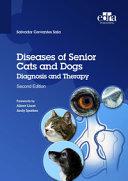DISEASES OF SENIOR CATS AND DOGS. DIAGNOSIS AND THERAPY 2º ED.

Tato kniha se komplexně zabývá geriatrickou medicínu psů a koček. Poskytuje čtenářům, ať už veterinárním lékařům nebo studentům veterinární medicíny, jiný přístup ke klinicky užitečným informacím o stárnoucích pacientech. Všechny kapitoly byly pečlivě přezkoumány a aktualizovány se zvláštním důrazem na farmakologické protokoly a dávkování a nové terapie. Byla přidána zcela nová kapitola o endokrinních problémech u starších domácích mazlíčků.
Autor: Salvador Cervantes Sala
| Nakladatel | Edra Publishing |
|---|---|
| ISBN | 9781957260105 |
| Vydání | 2022 |
| Vazba | brožovaná |
| Počet stran | 376 |
Salvador Cervantes
Sala Salvador Cervantes Sala received his degree in veterinary medicine from the Autonomous University of Barcelona (UAB), Spain, in 1998. Between 2000 and 2002 he completed courses in feline medicine and surgery at the European School for Advanced Veterinary Studies (ESAVS) at the University of Zurich, Switzerland. In 2009, he completed the Feline Internal Medicine course taught by the Centre for Veterinary Education at the University of Sydney, Australia. In 2001, together with his wife, Anna Calvet, he founded S&A Veterinaris, a veterinary clinic in Barcelona. In 2016, he founded Clínica Felina Barcelona, a veterinary hospital specifically for cats, located in the same city.
Salvador is a member of the American Association of Feline Practitioners (AAFP), the International Society of Feline Medicine (ISFM), and the Feline Medicine Study Group of the Spanish Association of Small Animal Veterinary Specialists (GEMFE–AVEPA). He has participated in several congresses and is the author of multiple articles on feline medicine published in international journals, including an article on feline hypertension titled “ISFM consensus guidelines on the diagnosis and management of hypertension in cats”, published in 2017 in the Journal of Feline Medicine and Surgery. In addition, he has co-authored the European edition of the GRAM (Guidance for the Rational use of Antimicrobials) guide, published by Ceva Santé Animale in 2016.
1. Ageing in small animals Ageing in numbers
Definition of ageing and preliminary clarifications
Physiology of ageing: why do we age?
Consequences of ageing in cats and dogs
Consequences for owners and veterinary surgeons
The owner’s perspective
Key points veterinary practitioners should bear in mind
2. Nutrition in elderly patients Assessing the nutritional status of geriatric patients
Effects of age on nutritional needs
Diets for nutrition-sensitive diseases
The owner’s perspective
Key points veterinary practitioners should bear in mind
3. Pharmacological treatment of geriatric patients
Basic concepts in pharmacology
Dose adjustments for geriatric patients
Pharmacological changes in patients with chronic kidney disease
Pharmacological changes in patients with liver disease
Pharmacological changes in patients with heart disease
The owner’s perspective
Key points veterinary practitioners should bear in mind
4. Anaesthesia in elderly patients
Anaesthesia: secrets, magic protocols, and other myths
How to design a personalised protocol for each case
The owner’s perspective
Key points veterinary practitioners should bear in mind
5. Environmental enrichment for cats and dogs
Species-specific objectives of environmental enrichment
Animate enrichment
Inanimate enrichment
When should an environmental enrichment plan be implemented?
How can we tell if environmental enrichment is working correctly?
The owner’s perspective
Key points veterinary practitioners should bear in mind
6. Chronic pain. Arthrosis Introduction. Definitions and basic concepts Pathophysiology of pain Identifying pain
Treatment of chronic pain
Analgesic agents Osteoarthritis
The owner’s perspective
Key points veterinary practitioners should bear in mind
7. Orodental problems in elderly animals Considerations before starting The orodental exam
Preparing patients for anaesthesia
Dental prophylaxis
How to complete a patient’s dental file
The owner’s perspective
Key points veterinary practitioners should bear in mind
8. Chronic kidney disease Definition and prevalence Renal physiology
Diagnostic techniques and early diagnosis
IRIS classification
Evidence-based treatment of CKD
The owner’s perspective
Key points veterinary practitioners should bear in mind
9. Liver problems in geriatric patients
Inflammatory liver diseases
Infiltrative liver diseases
Canine hepatic fibrosis and cirrhosis
Hepatocutaneous syndrome Liver tumours
Hepatic encephalopathy
The owner’s perspective
Key points veterinary practitioners should bear in mind
10. Endocrine problems in senior patients
Diabetes mellitus Hyperadrenocorticism or Cushing’s syndrome
Feline hyperthyroidism
The owner’s perspective
Key points veterinary practitioners should bear in mind
11. Reproductive diseases in senior patients
Benign prostatic hyperplasia Pyometra
Mammary tumours
The owner’s perspective
Key points veterinary practitioners should bear in mind
12. Senior cardiovascular disease
Cardiovascular physical examination
Mitral valve endocardiosis or degenerative mitral valve disease
Hypertrophic cardiomyopathy (HCM) or hypertrophic cardiomyopathy phenotype in cats
Feline hypertension
The Owner’s perspective
Key points veterinary practitioners should bear in mind
13. Most frequent neurological problems in senior patients
Cognitive dysfunction syndrome (CDS)
Vestibular system involvement in senior animals
Degenerative myelopathy
The owner’s perspective
Key points veterinary practitioners should bear in mind
14. Health plans in senior animals
Approach to the senior health programme
Helpful advice in difficult situations
The owner’s perspective
Key points veterinary practitioners should bear in mind
15. Bibliography